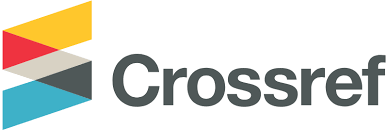BANJIR INFODEMI: VIRALITAS AKURASI BERITA VIROLOGI DALAM FENOMENA CORONAVIRUS DISEASE
Abstrak
Viralitas isu pandemi COVID-19 yang dikenal sebagai infodemi mengacu pada berbagai hasil kajian, termasuk pernyataan WHO dan UNESCO, diprediksi bergerak lebih cepat dan liar ketimbang penyebaran virus itu sendiri. Fenomena ini ditengarai sebagai pandemi global, yang nyata dan eksesif, membiak di hampir semua negara. Kegugupan global serta kegagapan otoritas negara dan masyarakat, diyakini sebagai faktor penyebab kian meluasnya disinformasi. Banjir infodemi diyakini karena penggunaan berbagai platform media sosial oleh para pihak sebagai ajang disinformasi: menyuplai informasi yang tidak akurat, terdistorsi, dan palsu. Berbagai studi terdahulu telah menguji bagaimana disinformasi dibagikan, dikonsumsi, dan mengarahkan publik untuk melakukan aktivitas keliru. Realitas ini kian memperumit kebijakan penanganan pandemi. Kajian kualitatif ini menyimpulkan, jika fenomena banjir infodemi tidak ditangani secara serius oleh pihak pemilik otoritas, potensial memicu ketidakpercayaan publik terhadap tanggung jawab institusi global dan otoritas negara, memantik sikap apatis publik dalam mengantisipasi dan menangani bahaya wabah secara kolektif. Berdasarkan temuan tersebut, kajian ini merekomendasi institusi global dan otoritas negara untuk mengambil langkah yang lebih tegas, preventif, dan terukur serta aktif memberi edukasi dan literasi media pada publik terkait isu disinformasi yang hingga kini terus membanjiri ruang media sosial.
Kata Kunci
Teks Lengkap:
PDFReferensi
“Akurat”. Retrieved December 28, 2020, from https://kbbi.web.id/akurat.
Adamic, Lada A., & Adar, Eytan (2003). Friends and neighbors on the web. Social Networks, 25(3): 211-230. https://doi.org/10.1016/S0378-8733(03)00009-1.
Andreotta, Matthew, et.al. (2019). Analyzing social media data: A mixed-methods framework combining computational and qualitative text analysis. Behavavior Research Methode, 51(3): 1766–1781. https://doi.org/10.3758/s13428-019-01202-8.
Ardianto, Elvirano, dkk. (2011). Komunikasi massa: Suatu pengantar. Bandung: Simbiosa Rekatama.
Bafadhal, Oemar Madri & Santoso, Anang Dwi (2020). Memetakan pesan hoaks berita covid-19 di Indonesia lintas kategori, sumber, dan jenis disinformasi. Bricolage: Jurnal Magister Ilmu Komunikasi, 6(2): 235-249. http://dx.doi.org/10.30813/bricolage.v6i02.2148.
Bogdan, Robert C., & Biklen, Sari Knoop (1982). Qualitative research of education: An introduction to theory and methods. Boston: Allyn and Bacon. Inc.
Bruno Kessler Foundation (2020). Fake news in the time of C-19. Retrieved December 30, 2020, from https://members.tortoisemedia.com/2020/03/23/the-infodemic-fake-news-coronavirus/content.html.
Budiprasetyo, Gunawan (2013). Analisis Jaringan Sosial Menggunakan Teknik Penambangan Web. Retrieved December 29, 2020, from https://mygugum.wordpress.com/2013/11/17/analisis-jaringan-sosial-menggunakan-teknik-penambangan-web/
Carvin, Andy (2020). Webinar 20: Covering an Infodemic: Disinformation Surrounding COVID-19. International Center for Journalists (ICFJ). Retrieved December 23, 2020, from https://www.youtube.com/watch?v=pTHHkmcsAkM.
Caulfeld, Timothy (2020). Pseudoscience and COVID-19-we’ve had enough already (Nature Article, April 27, 2020). Retrieved December 29, 2020, from https://www.nature.com/articles/d41586-020-01266-z. doi: https://doi.org/10.1038/d41586-020-01266-z.
Charnley, Mitchell V. (1936). Preliminary notes on a study of newspaper accuracy. Journalism & Mass Communication Quarterly, 13(4): 394-401. https://doi.org/10.1177/107769903601300403.
Colla, Marcus (2020). The vanishing hegemon (The Interpreter Article, December 31, 2020). Retrieved December 24, 2020, from https://www.lowyinstitute.org/the-interpreter/vanishing-hegemon.
Covid19 Infodemics Observatory (2020). Retrieved December 29, 2020, from https://covid19obs.fbk.eu/#/
Cuan-Baltazar, Jose Yunam, et.al. (2020). Misinformation of COVID-19 on the internet: infodemiology study. JMIR Public Health and Surveillance, 6(2): e18444. http://doi.org/10.2196/18444.
Crawford, Dorothy H. (2011). Viruses: A very short introduction. New York: Oxford University Press.
Creeber, Glen & Martin, Royston (ed.) (2009). Digital cultures: Understanding new media. Berkshire-England; New York: Open University Press.
Creswell, John W. (2013). Research design: Pendekatan kualitatif, kuantitatif, dan mixed (Terjemahan). Yogyakarta: Pustaka Pelajar.
Deriani, Ni Wayan (2017). Evaluasi pemanfaatan media sosial sebagai media pemasaran rumah makan/coffee di Denpasar. E-Proceeding Konferensi Nasional Sistem & Informatika STIMIK STIKOM Bali, pp. 334-339. e-ISSN: 2460-8378. Retrieved December 28, 2020, from https://knsi.stikom-bali.ac.id/index.php/eproceedings/article/download/62/58/
Dijk, Jan van (2006). The network society: Social aspects of new media (2nd ed.). London, Thousand Oaks-CA, New Delhi: Sage Publications, Inc.
Dolorosa, Gloria Natalia (2020). “Studi: Infodemik Paling Banyak di 6 Negara, Termasuk Indonesia” Retrieved December 26, 2020, from https://www.kompas.com/tren/read/2020/09/27/090000665/studi--infodemik-paling-banyak-di-6-negara-termasuk-indonesia?page=all.
Elflein, John (2021). “Number of coronavirus (COVID-19) cases worldwide as of February 5, 2021, by country” Retrieved January 3, 2021, from https://www.statista.com/statistics/1043366/novel-coronavirus-2019ncov-cases-worldwide-by-country/
Floridi, Luciano (2008). Philosophy of information and information ethics: Critical reflections and the state of the art. Ethics and Information Technology, 10(2): 89–96. https://doi.org/10.1007/s10676-008-9172-8.
Gustomy, Rachmad (2020). Pandemi ke infodemi: Polarisasi politik dalam wacana covid-19 pengguna twitter. JIIP: Jurnal Ilmiah Ilmu Pemerintahan, 5(2): 190-205. https://doi.org/10.14710/jiip.v5i2.8781.
Handayani, Sri Ana (2020). Humaniora dan era disrupsi teknologi dalam konteks historis. UNEJ e-Proceeding, 1(1): 19-30. ISBN: 978-623-7973-08-9.
Hansen, Derek L., et al. (2012). Do you know the way to SNA?: A process model for analyzing and visualizing social media network data. International Conference on Social Informatics (Social Informatics): 304–313. DOI:10.1109/SocialInformatics.2012.26.
Hayakawa, Samuel Ichiye & Hayakawa, Alan R. (1990). Language in thought and action. San Diego (NY): Harcourt Brace Jovanovich.
Hester, Joe & Dougall, Elizabeth (2007). The efficiency of constructed week sampling for content analysis of online news. Journalism & Mass Communication Quarterly, 84(4): 811-824. https://doi.org/10.1177/107769900708400410.
Hua, Jinling & Shaw, Rajib (2020). Corona virus (COVID-19) “infodemic” and emerging issues through a data lens: The case of china. International Journal of Environmental Research and Public Health, 17(7): 230-239. http://doi.org/10.3390/Ijerph17072309.
Ignacio, Hernandez-García & Gimenez-Julvez, Teresa (2020). Assessment of health information about COVID-19 prevention on the internet: Infodemiological study. JMIR Public Health and Surveillance, 6(2): e18717. http://doi.org/10.2196/18717.
Influencer Marketing Hub. (2020). The state of influencer marketing 2020: Benchmark report. Retrieved December 27, 2020, from https://influencermarketinghub.com/influencer-marketing-benchmark-report-2020/
“Infodemic” Retrieved January 28th, 2021, from https://en.wikipedia.org/wiki/Infodemic.
“Infodemic” Retrieved January 28th, 2021, from https://www.lexico.com/en/definition/infodemic.
Islam, Md. Saiful, et.al. (2020). COVID-19–related infodemic and its impact on public health: A global social media analysis. The American Journal of Tropical Medicine and Hygiene, 103(4): 1621–1629. https://doi.org/10.4269/ajtmh.20-0812.
Juditha, Christiany (2013). Akurasi berita dalam jurnalisme online (Kasus dugaan korupsi Mahkamah Konstitusi di portal berita detiknews). Jurnal Pekommas, 16(3): 145-154. http://dx.doi.org/10.30818/jpkm.2013.1160301.
Launa (2020). Sandiaga Uno dalam konstruksi media. Jurnal Penelitian Komunikasi, 23(1): 31-46. https://doi.org/10.20422/jpk.v23i1.656.
Lazonder, Ard W., Biemans, Harm J.A., & Wopereis, Iwan G.J.H. (2000). Differences between novice and experienced users in search information on the World Wide Web. Journal of The American Society for Information Science, 51(6): 576-581. https://doi.org/10.1002/(sici)1097-4571.
Levy, Pierre (2001). Cyberculture: Electronik mediations (Vol. 4). Minneapolis (London): University of Minnesota Press.
Lievrouw, Leah A. (2011). Alternative and activist new media. Oxford, United Kingdom: Polity Press.
McQuail, Dennis (2011). Teori komunikasi massa (Terjemahan). Jakarta: Salemba Humanika.
Merrill, John C. (1965). How time stereotyped three U.S. presidents. Journalism & Mass Communication Quarterly, Vol. 42: 563-570. https://doi.org/10.1177/107769906504200406.
Miles, Matthew B. & Huberman, Michael A. (1992). Analisis Data Kualitatif (Terjemahan). Jakarta: Universitas Indonesia Press.
Molter, Vannesa & DiResta, Renne (2020). Pandemics & propaganda: How Chinese state media creates and propagates CCP coronavirus narratives (Research Article). Harvard Kennedy School (HKS) Misinformation Review. 1(Special Issues): 1-24. https://doi.org/10.37016/mr-2020-025.
Mondry (2008). Pemahaman teori dan praktik jurnalistik. Bogor: Ghalia Indonesia.
Naeem, Salman bin, Bhatti, Rubina & Khan, Aqsa (2020). An exploration of how fake news is taking over social media and putting public health at risk. Health Information and Libraries Journal, July 12, 2020 (Version of Record Online): 1-7. https://doi.org/10.1111/hir.12320.
naturresearch.com (2020). “Virology” Retrieved December 26, 2020, from https://www.nature.com/subjects/virology.
“News Items Text: Definition, Generic Structures, Purposes, Language Features.” Retrieved December 25, 2020, from http://britishcourse.com/news-items-text-definition-generic-structures-purposes-language-features.php.
Nurhanisah, Yuli (2020). “Setop Sebarkan Hoaks Covid-19!” Retrieved December 30, 2020, from http://indonesiabaik.id/infografis/setop-sebarkan-hoaks-covid-19.
Nurhayati-Wolf, Hanadian (2021). “Total cases of COVID-19 Indonesia 2021.” Retrieved January 3, 2021, from https://www.statista.com/statistics/1103469/indonesia-covid-19-total-cases/
PAHO (2020). Understanding the infodemic and misinformation in the fight against Covid-19. Retrieved December 30, 2020, from https://iris.paho.org/bitstream/handle/10665.2/52052/Factsheet-infodemic_eng.pdf?sequence=5.
Petchot, Kamonwan (2020). “Fake news in the time of COVID-19”. Retrieved January 29, 2021, from https://bangkok.unesco.org/index.php/content/press-provides-antidote-fake-news-time-covid-19.
Pozin, Ilya (2014). “6 Qualities To Make Your Videos Go Viral”. Retrieved December 29, 2020, from https://www.forbes.com/sites/ilyapozin/2014/08/07/6-qualities-to-make-your-videos-go-viral/?sh=daa90cc154e5.
Rivers, Wililiam L., Jensen, W. Jay & Peterpon, Theodore (2003). Media massa dan masyarakat modern (Terjemahan). Jakarta: Kencana Prenada Media Group.
Romli, Asep Syamsul M. (2014). Jurnalistik online: Panduan mengelola media online. Bandung: Nuansa Cendikia.
Rothkopf, David J. (2003). “When the buzz bites back” (Washington Post Article, May 11, 2003), Retrieved December 23, 2020, from https://www.washingtonpost.com/archive/opinions/2003/05/11/when-the-buzz-bites-back/bc8cd84f-cab6-4648-bf58-0277261af6cd/
Salve, Prachi (2020). “Study: Manipulative fake news on the rise in India under lockdown” (IndiaSpend article, May 3, 2020—Editing by Pooja Vashisht Alexander). Retrieved December 30, 2020, from https://www.indiaspend.com/manipulative-fake-news-on-the-rise-in-india-under-lockdown-study/
Sugiyono (2012). Metode penelitian kuantitatif, kualitatif dan R&D. Bandung: Alfabeta.
Starbird, Kate (2020). Disinformation campaigns are murky blends of truth, lies and sincere beliefs–Lessons From the Pandemic”. Retrieved December 28, 2020, from https://theconversation.com/disinformation-campaigns-are-murky-blends-of-truth-lies-and-sincere-beliefs-lessons-from-the-pandemic-140677.
Teluma, Aurelius R.L. (2020). Membaca realitas infodemi Covid-19 di Indonesia. Journal of Media and Communication Science, 1(1): 1-9. https://doi.org/10.29303/jcommsci.v1i1.91.
Ting, I-Hsien (2008). Web mining techniques for on-line social networks analysis. International Conference on Service Systems and Service Management, Melbourne, VIC, 2008, pp. 1-5. doi: 10.1109/ICSSSM.2008.4598506.
Trew, Bel (2020). Coronavirus: Hundreds dead in Iran from drinking methanol amid fake reports it cures disease (Independent article, March 27, 2020). Retrieved December 31, from https://www.independent.co.uk/news/world/middle-east/iran-coronavirus-methanol-drink-cure-deaths-fake-a9429956.html.
Tsoucalas, Gregory, et.al. (2016). The 1918 Spanish flu pandemic, the origins of the H1N1-virus strain, a glance in history. European Journal of Clinical and Biomedical Sciences, 2(4): 23-28. https://doi.org/10.11648/j.ejcbs.20160204.1.
Westerstahl, Jorgen L. (1983). Objective news reporting: General premises. Communication Research, 10(3): 403-424. https://doi.org/10.1177/009365083010003007.
Venkatachalam, Anuja (2020). Internet searches on fake news, misinformation and disinformation peak during COVID-19 (Health Matters Asia Report, August 21, 2020). Retrieved December 24, 2020, from https://www.ha-asia.com/internet-searches-on-fake-news-misinformation-and-disinformation-peak-during-covid-19/
“Virality.” Retrieved December 29, 2020, from https://www.dictionary.com/browse/virality.
“Virology.” Retrieved December 28, 2020, from https://en.wikipedia.org/wiki/Virology.
“Virology.” Retrieved December 28, 2020, from https://www.merriam-webster.com/dictionary/virology.
Yuliana, Irma (2019). Adopsi social network analysis (SNA) dalam upaya membangun ketangguhan bencana di masyarakat. JIKO: Jurnal Informatika dan Komputer, 2(2): 49-54. http://dx.doi.org/10.33387/jiko.
WHO (2020a). Novel Coronavirus. In World Health Organization Situation Report 13. Retrieved December 28, 2020, from https://www.who.int/docs/defaultsource/coronaviruse/situation-reports/20200202-sitrep-13-ncov-v3.pdf.
WHO (2020b). Munich Security Conference. Retrieved December 25, 2020, from https://www.who.int/director-general/speeches/detail/munich-security-conference.
“Words We're Watching: Infodemic.” Retrieved January 28th, 2021, from https://www.merriam-webster.com/words-at-play/words-were-watching-infodemic-meaning.
Zimmer, Ben (2020). “Infodemic: When unreliable information spreads far and wide” (The Wall Street Journal Article,
DOI: https://doi.org/10.36441/thesource.v2i2.305
Article Metrics
Abstrak views : 1358 times
PDF views : 1358 times
Dimension Citation Metrics
Refbacks
- Saat ini tidak ada refbacks.
Article Metrics
Abstrak views : 1358 timesPDF views : 1358 times
Dimension Citation Metrics
Refbacks
- Saat ini tidak ada refbacks.
Refbacks
- Saat ini tidak ada refbacks.
Jurnal Ini Terindeks di:
 Ciptaan disebarluaskan di bawah Lisensi Creative Commons Atribusi 4.0 Internasional.
Ciptaan disebarluaskan di bawah Lisensi Creative Commons Atribusi 4.0 Internasional.






